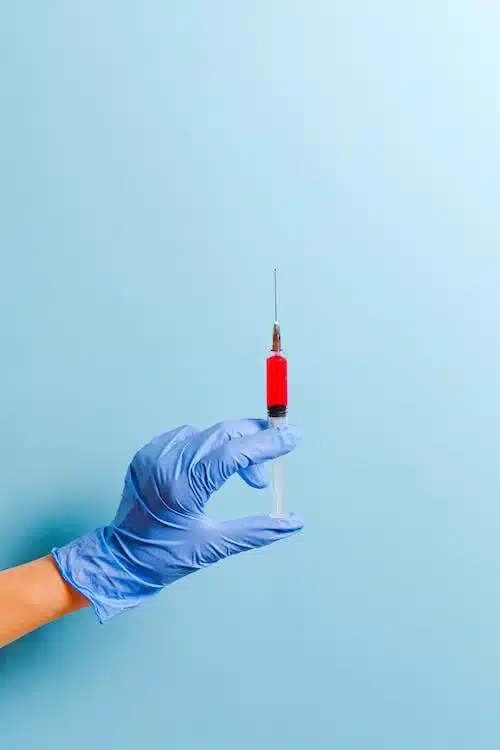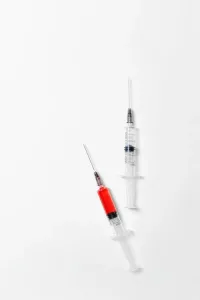Platelet-rich plasma (PRP) injections are a form of treatment that involves injecting a concentration of a patient’s own platelets into an area of the body to promote healing and tissue regeneration. Platelets are a type of blood cell that plays a crucial role in the body’s natural healing process. They contain proteins called growth factors that help to stimulate the production of collagen, a protein that is essential for the repair and rebuilding of tissues such as skin, tendons, and ligaments.
Platelet-rich plasma injections have been used to treat a variety of conditions, including muscle and tendon injuries, osteoarthritis, and chronic pain. They have also been used in the field of aesthetics to improve the appearance of skin, reduce the appearance of scars, and stimulate hair growth. (1)
How are PRP Injections Done
PRP injections are typically performed in a cosmetic dermatologist or cosmetic surgeon office or clinic. The process begins with the collection of a small sample of the patient’s blood, which is then placed in a centrifuge to separate the platelets from the other components of the blood. The concentrated platelets are then mixed with a small amount of the patient’s plasma (the liquid portion of the blood) to create the PRP solution.

The Platelet-rich plasma solution is then injected into the target area using a needle or other specialized delivery device. The injections can be done under local anesthesia to minimize discomfort.
Are Platelet-rich Plasma (PRP) Effective?
PRP injections have been shown to be effective in the treatment of various musculoskeletal conditions, including tendinitis, muscle strains, and ligament sprains. They have also been used to treat osteoarthritis, a degenerative joint disease that can cause pain and inflammation. In these cases, the PRP injections are thought to help stimulate the production of new cartilage, which can help to reduce pain and improve joint function.
Risks of PRP
There are some potential risks and side effects associated with PRP injections as there are with all cosmetic procedures. These may include pain at the injection site, swelling, and bleeding. There is also a risk of infection, although this is rare.
Other Uses for PRP Platelet-rich Plasma
PRP injections have also been used to treat chronic pain conditions, such as chronic back pain and neck pain. In these cases, the injections are thought to help stimulate the production of new nerve cells, which can help to reduce pain and improve function.
PRP injections have also been used in the field of aesthetics to improve the appearance of skin and reduce the appearance of scars. They are thought to stimulate the production of collagen, which can help to improve the texture and tone of the skin. Platelet-rich plasma injections have also been used to stimulate hair growth in people with male-pattern baldness or other types of hair loss.

When Should You Not Use PRP Injections
There are certain situations in which PRP injections may not be appropriate.
Some examples of when PRP injections may not be recommended include:
- Active infections: If a person has an active infection, PRP injections may not be recommended as the injection could potentially spread the infection. (5)
- Blood disorders: If a person has a blood disorder that affects their platelets, such as thrombocytopenia or von Willebrand disease, PRP injections may not be recommended.
- Cancer: If a person has cancer or a history of cancer, PRP injections may not be recommended due to the risk of spreading cancer cells.
- Pregnancy: PRP injections are generally not recommended for pregnant women due to the lack of research on the safety of PRP injections during pregnancy.
How Much Do Platelet-Rich Plasma Injections Cost
The cost of Platelet-Rich Plasma (PRP) injections can vary depending on a number of factors, including the specific condition being treated, the location of the treatment, and the experience and qualifications of the practitioner administering the injections.
In general, PRP injections tend to be more expensive than traditional treatments, such as corticosteroid injections, due to the additional cost of preparing the PRP.
The cost of a single PRP injection session can range from $500 to $3000. However, multiple sessions may be required for best results, which can increase the overall cost.
Additionally, some insurance plans may cover the cost of PRP injections if they are being used to treat a specific condition, such as osteoarthritis or tendinitis. However, many insurance plans do not cover the cost of PRP injections, as they are considered experimental or investigational.
Another important thing to consider is that not all PRP treatments are created equal and some clinics might charge more due to the use of latest technology and devices.
Platelet-rich plasma injections are a promising treatment option for a variety of musculoskeletal conditions and aesthetic concerns. However, more research is needed to fully understand their potential benefits and risks. It is important for patients to consult with a healthcare professional to determine if PRP injections are an appropriate treatment option for their specific condition.
PRP References
Platelet–Rich Plasma for Hair Restoration.
Platelet–Rich Plasma for Skin Rejuvenation: Facts, Fiction, and Pearls for Practice.
Platelet–rich plasma, the ultimate secret for youthful skin elixir and hair growth triggering.
I like that you pointed out how PRP injections could be used in the field of aesthetics to improve the appearance of skin and reduce the appearance of scars. We recently learned about PRP injections and it was quite fascinating. It looks like my wife is very interested, so maybe she should try it out.
Comments are closed.